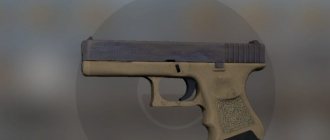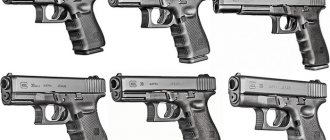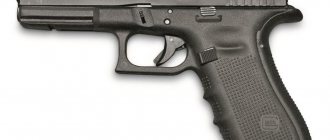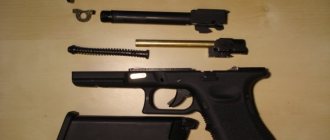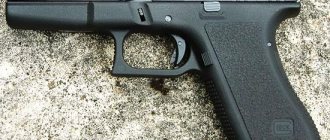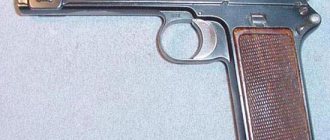Description
The Glock 26 is the company's subcompact pistol, chambered in 9x19 mm NATO caliber. Just like the “ancestor” of the series, the body of the pistol is made of composite - a polyamide base, with reinforcing elements fused into it, which has a positive effect on its strength and weight. Also, the ergonomics of the weapon have not undergone any significant changes - owners of “full-scale” pistols from the Austrian company do not experience any particular difficulties when operating the compact model.
Due to its size, the Glock 26 is loved not only by civilians, but also by members of various special forces around the world.
Encyclopedia of weapons
Glock 26 pistol, Subcompact model, Austria
Performance characteristics of Glock 26
Caliber, mm — 9×19 mm Parabellum Length, mm — 160 Barrel length, mm — 88 Sighting line length, mm — 144 Height, mm — 106 Width, mm — 30 Rifling — right-handed, hexagonal, pitch 250 mm Weight without cartridges, g — 615 Curb weight, g — 740 Magazine capacity, cartridges — 10 optionally 12; 15; 17; 33
In 1995, it released the Glock 26 “pocket” pistol chambered for the 9×19 Parabellum cartridge. The Glock 26 introduced the Glock family of ultra-compact pistols, allowing the owner to carry it concealed under light clothing. At the same time, having sufficiently high, for a weapon of this class, firepower and stopping effect of the bullet of the cartridge used.
The subcompact (Subcompact - small-sized) pistol Glock 26 is another modification of the basic model Glock 17. However, changes were made to the new pistol to reduce the size of the weapon. The barrel, bolt casing, frame and handle have been significantly shortened.
Due to the shortened space under the barrel, the return mechanism was changed - instead of one return spring on a solid guide rod, a telescopic rod was introduced with one spring on the outer tube and one on the inner tube. The front and rear edges of the bolt casing are rounded so that the contours of the weapon do not stand out when carried concealed.
The automatic weapon, as in the base model, works due to the recoil of the barrel during its short stroke. The barrel bore is locked by the upper protrusion of the barrel entering the window of the bolt casing. The barrel bore is unlocked by lowering its breech down using the lower breech boss and axis during recoil of the barrel.
All metal parts of the Glock 26 model are processed using Tennifer technology. As a result of this treatment, the surface to a depth of 0.05 mm acquires a hardness of about 69 Rockwell units (for comparison, the hardness of industrial diamonds is 71-72).
The U-shaped shutter casing is made of steel using high-precision casting and subjected to special treatment to increase corrosion and wear resistance. Hexagonal bore with six rifling. The barrel, as well as the bolt casing, is treated with a special tenifer coating.
The pistol frame, together with the handle and trigger guard, is made of high-strength polymer plastic. The guide frames along which the steel shutter-casing moves are reinforced with steel inserts.
The pistol has a striker-fired trigger mechanism, the so-called “Safe Action”, with 3 automatic safeties, including one on the trigger.
A feature of the “safe action” trigger is that during the reloading cycle of the pistol, the firing pin is only partially cocked, while it is blocked using an automatic safety lock.
The firing pin is re-cocked only when the trigger is pressed, while the firing pin remains blocked from moving forward until the trigger is fully pulled. Thus, it is possible to achieve a uniform force on the trigger from the first to the last shot, which has a positive effect on shooting accuracy. The standard trigger force is 2.5 kg.
Open-type sighting devices are mounted on the flat upper surface of the bolt housing and include a replaceable permanent front sight with a sight. As standard, the front sight is equipped with a luminous dot, and the rectangular slot of the sight is framed by a luminous frame.
The standard supply of ammunition to the pistol is carried out from a short detachable box magazine with a double-row arrangement of 10 rounds in a checkerboard pattern, as well as 12, 15, 17 and 33.
The short pistol grip provides support for only two fingers. To compensate for this, the handle is equipped with front and side finger grooves.
However, the recoil of the Glock 26 is greater than that of larger models with more weight and more ergonomic grips. The small handle does not provide support for the little finger, which negatively affects shooting accuracy. But when using magazines with a capacity of 12 rounds, which have a cover with a protruding front part for resting the little finger, the retention becomes more stable.
The pistol has the same qualities as previous models of the Glock family - simplicity, safety in handling and ease of maintenance, as well as a long service life and very high reliability in difficult operating conditions.
The weapon does not have high initial speed and bullet energy due to the short barrel length, as a result of which, to achieve high shooting efficiency, it is recommended to use the technique of high-speed aimed shooting in series and the use of cartridges with modern expansive bullets, which is quite enough to quickly stop the attacking enemy.
The compactness and lightness of the Glock 26 make constant concealed carry comfortable and not tiring. Maintaining the size of the trigger guard, the trigger pull of about 2.5 kg and the position of the magazine latch allowed shooters familiar with full-size Glock combat models to easily master the “pocket” ones.
The Glock 26 pistol was primarily designed for the consumer market, but has become an ideal compact pistol for law enforcement officers. At one time, it was adopted by the Finnish police, the Los Angeles Police Department, the special forces of the US Army, and also gained enormous popularity in the civilian arms market of the United States and other countries of the world.
‹ Glock 25 Up Glock 27 ›- 36623 views
Design
Technically, the Glock 26 is similar to its ancestor (Glock 17), although there are very noticeable differences in the return mechanism. The subcompact's automatic system operates due to the short-stroke recoil of the barrel. The barrel bore is locked by the interaction of the protrusions on the breech of the barrel with the grooves on the inside of the bolt casing. The pistol does not have external mechanical safeties located on the outer surfaces of the pistol.
To avoid making the gun unnecessarily complex, the company's engineers used a telescopic return mechanism with two springs.
The telescopic return mechanism consists of two elements - the main rod and the coupling, connected by a spring. To soften recoil, two springs are installed on the mechanism - one softens the blow during the return movement of the bolt casing, the second acts as a returner. The shutter housing itself has slightly rounded front edges for greater inconspicuousness when worn under clothing.
The USM is a striker type with pre-cocking, equipped with three automatic shot blockers (safeties). One is traditionally located on the trigger, the rest are automatic. Full cocking of the striker occurs only when the trigger is fully squeezed, which allows you to keep the trigger resistance at the level of 2.4-2.6 kg for both the first and all subsequent shots.
Sights are represented by standard removable front sight and rear sight, also adapted for night shooting, having received the designation of a luminous mark on the front sight and U-shaped finishing of the rear sight slot.
Feeding in combat can be carried out either from a standard 10-round magazine with a staggered arrangement of cartridges, or from any magazine of the Glock family with a capacity of 12 to 33 rounds. At the same time, the handle is covered with only two fingers, which causes some inconvenience for inexperienced shooters, and also slightly increases the recoil when firing.
Pistols Glock 26 / Glock 27 (Austria)
Page 1 of 2
Gaston Glock's 9mm Parabellum pistol, the first of a series of pistols of his design, was introduced to the American public nearly a quarter of a century ago.
Since then, more than 4,500 local and federal law enforcement agencies in the United States have adopted the Glock pistol as their duty weapon. Law enforcement and military units from more than three dozen other countries have also adopted the Glock. In the 90s, two new ultra-compact Glock models were released onto the market - the Glock 26 chambered for 9 mm Parabellum and the Glock 27 chambered for .40 S&W.
After the Glock pistol was first imported into the United States, it received enormous public attention for its highly durable polymer frame that can withstand heat up to 200 degrees Celsius. Many considered this design to be unique, but it is not. The HK P9S pistol, introduced in the 1960s, had a frame with the trigger guard and the front of the grip made of plastic, and the rest of the body made of sheet metal. Because of this polymer frame, anti-gun politicians and their media minions argued that the Glock would be invisible when passed through an X-ray machine. But this is not at all true, since 83% of its mass is made up of metal parts. It cannot be carried through a properly configured metal detector without being noticed.
The automatic operation of all Glock operates on the principle of recoil of the barrel with a short stroke, where the bolt is connected to the barrel (locked) using a barrel protrusion that fits into the extraction window. During a shot, under the influence of powder gases, the barrel moves back about 3 mm until the bullet leaves it and the gas pressure drops to a safe level. After this, the barrel goes down, separating from the bolt and stops. Further operation of the automation when the bolt moves backwards and returns is carried out in a similar way to what happens in Browning pistols.
The striker-fired, that is, trigger-free, Glock trigger mechanism is completely unique. There is no hand-operated safety or lever that smoothly decocks the firing pin. The first stage of protection is an automatic fuse located on the trigger. In the wide, notched trigger there is a small, spring-loaded, internal trigger. Both of them are made of polymer. The outside trigger cannot be moved, such as by contact with the wall of the holster, until the inside trigger is pulled first. Thus, the trigger can only be triggered by pressing the center of the trigger, but not along its periphery.
A spring-loaded firing pin safety located in the bolt prevents forward movement of the firing pin and is released when moved upward by a protrusion on the sheet metal trigger rod when the trigger reaches its rearmost position when pulled.
Four steel bolt guides (each about 10 mm long) for the bolt are located in a die-cast frame, two each at the rear end of the frame and in front of the trigger guard. To meet NATO requirements, a steel plate is embedded in the frame in front of the trigger guard, on which the weapon number is applied. The trigger guard in the front part protrudes forward and has a notch. The grip angle (the angle between the line perpendicular to the axis of the bore and the front surface of the grip) for the entire Glock family is about 22 degrees, which is slightly steeper than most similar pistols. The surface of the handle is slightly rough, there are grooves for the thumb on both sides of the handle, and its back surface has a notch. On the front surface of the handle there are two grooves for the fingers for a more secure hold of the weapon.
The locking block, which engages the leading lug of the barrel, is probably the only precision investment casting part on all Glock pistols. It was somewhat shortened and modified due to the installation of a new design recoil mechanism the Glock 26 and Glock 27 The locking block is held in the frame by the same metal axle on which the trigger and bolt stop are mounted. The base of the trigger mechanism is attached to the frame by a polymer axle. The spring-loaded sheet metal part serves as a bolt stop and is protected from accidental manipulation by a lip molded into the frame. The bolt stop, controlled by a single curved leaf spring (shorter and slightly differently configured on the Glock 26 and Glock 27), engages the barrel with a ledge at the front of the locking lug to prevent the bolt from separating from the frame during a recoil impact. The magazine catch, another polymer part, is located where it was before, on the left side of the frame, directly behind the trigger guard, and is held in place by a “pin” spring. Both side surfaces of the magazine are beveled to the edges, which makes it easier to attach the magazine.
The bolt has a characteristic rectangular shape. The Glock 26 and Glock 27 have a slightly beveled slide towards the front end. Both the barrel and the bolt are subjected to a three-stage heat treatment. At the final stage, the parts are immersed in a nitride bath at a temperature of 500 degrees Celsius. In this way, a hardened surface layer of metal with a thickness of 0.04-0.05 mm is created. This matte, non-glare finish has 99 percent corrosion resistance in salt water and matches or exceeds the properties of stainless steel. In terms of corrosion resistance, it is 80 percent superior to even any chrome coating.
The large ejector window at the top of the right side of the pistol's bolt increases its functional reliability. The large ejector, located behind the extraction window on the right side of the bolt, is operated by a spring-loaded plunger, which, together with the firing mechanism, is held in place by a polymer plate. The slide checkering on all Glock pistols is deep enough to provide excellent retention when cocking the action.
<< First < Previous 1 Next > Last >>
Operating countries
Currently, the subcompact model of the Glock pistol is in service:
- Finnish Police Forces;
- Los Angeles Police Department (USA);
- Special forces units of the US police and army (model with the ability to install a silent firing device);
- Security services of the Austrian government, as well as special forces of the army and navy;
- Used as a reward weapon in the Russian Federation;
- Special forces of the army and police of Western Europe and the Balkan Peninsula, as well as India, Pakistan and Malaysia.
In addition to the above, despite the supposed “highly specialized” focus of the Glock 26, the pistol is legally sold to civilians in the United States and many European countries (of course, in the basic version).
Updated fifth generation Glock 26 subcompact
In 2022, a new modification of the fifth-generation subcompact model was presented to the general public. Changes included the coating of the external surfaces of the case, the installation of an ambidextrous bolt stop lever, and the replacement of the base barrel with a Marksman Barell version (carried over from the sports model). In addition, changes were made to the handle - as on all fifth-generation Glock models, the finger grooves disappeared, and the neck of the shaft was increased in size. The magazine itself has also undergone changes - it has been modified to reduce delays in the supply of ammunition.
Technical characteristics of the Glock 26 gen5 pistol (all generations of the 26th)
| Characteristics | Glock 26 gen 4 | Glock 26 gen 5 |
| Caliber, mm | 9x19 mm NATO | 9×19mm NATO |
| Weapon length, mm | 160 | 160 |
| Barrel length, mm | 88 | 88 |
| Weapon height, mm | 106 | 106 |
| Weapon width, mm | 33 | 33 |
| Gun weight, kg | 0,56 | 0,56 |
| Trigger force, kg | 2,5 | 2,6 |
| Magazine capacity, cartridges | 10 (12/15/17/19/24/31/35) | 10 (12/15/17/19/24/31/35) |
Glock 26 pistol
| Glock 26 |
Glock 26 incomplete disassembly
In 1995, it released the Glock 26 “pocket” pistol chambered for 9×19 mm Parabellum.
The Glock 26 introduced the Glock family of ultra-compact pistols, allowing the owner to carry it concealed under light clothing. At the same time, having sufficiently high, for a weapon of this class, firepower and stopping effect of the bullet of the cartridge used.
The subcompact (Subcompact - small-sized) pistol Glock 26 is another modification of the basic model Glock 17, with which it is completely identical in design.
However, changes were made to the new pistol to reduce the size of the weapon. The barrel, bolt casing, frame and handle have been significantly shortened. Due to the shortened space under the barrel, the return mechanism was changed - instead of one return spring on a solid guide rod, a telescopic rod was introduced with one spring on the outer tube and one on the inner tube. The front and rear edges of the bolt casing are rounded so that the contours of the weapon do not stand out when carried concealed.
| Glock 26 |
| Caliber, mm | 9×19 Parabellum |
| Length, mm | 160 |
| Barrel length, mm | 88 |
| Height with magazine, mm | 106 |
| Width, mm | 30 |
| Weight, kg (without magazine / equipped) | 0.560 / 0.740 |
| Magazine weight, kg (without cartridges / loaded) | 0.056 / 0.180 |
| Store, count. cartridges | 10 (12; 15; 17; 19; 33) |
The automatic weapon, as in the base model, works due to the recoil of the barrel during its short stroke. The barrel bore is locked by the upper protrusion of the barrel entering the window of the bolt casing. The barrel bore is unlocked by lowering its breech down using the lower breech boss and axis during recoil of the barrel.
The U-shaped shutter casing is made of steel using high-precision casting and subjected to special treatment to increase corrosion and wear resistance.
Glock 26
Hexagonal bore with six rifling. The barrel, as well as the bolt casing, is treated with a special tenifer coating.
The pistol has a striker-fired trigger mechanism, the so-called “Safe Action”, with 3 automatic safeties, including one on the trigger. A feature of the “safe action” trigger is that during the reloading cycle of the pistol, the firing pin is only partially cocked, while it is blocked using an automatic safety lock. The firing pin is re-cocked only when the trigger is pressed, while the firing pin remains blocked from moving forward until the trigger is fully pulled. Thus, it is possible to achieve a uniform force on the trigger from the first to the last shot, which has a positive effect on shooting accuracy. The standard trigger force is 2.5 kg.
| Glock 26 |
Glock 26
Open sights are mounted on the flat top surface of the slide and include an interchangeable permanent front sight and sight. As standard, the front sight is equipped with a luminous dot, and the rectangular slot of the sight is framed by a luminous frame.
The pistol is normally fed with ammunition from a short detachable box magazine with a double-row arrangement of 10 rounds in a checkerboard pattern.
In addition, it is possible to use magazines with a capacity of 12 rounds, as well as 15, 17, 19 and 33 rounds from the Glock 17, Glock 18 and Glock 19 models. Magazines from Glock 26
The pistol frame, together with the handle and trigger guard, is made of high-strength polymer material (plastic). The guide frames along which the steel shutter-casing moves are reinforced with steel inserts.
The short pistol grip provides support for only two fingers. To compensate for this, the handle is equipped with front and side finger grooves.
Glock 26 mounted on the shin
All metal parts of the Glock 26 model are processed using Tennifer technology. As a result of this treatment, the surface to a depth of 0.05 mm acquires a hardness of about 69 Rockwell units (for comparison, the hardness of industrial diamonds is 71-72).
The pistol has the same qualities as previous models of the Glock family - simplicity, safety in handling and ease of maintenance, as well as a long service life and very high reliability in difficult operating conditions.
However, the recoil of the Glock 26 is greater than that of larger models with more weight and more ergonomic grips. The small handle does not provide support for the little finger, which negatively affects shooting accuracy. But when using magazines with a capacity of 12 rounds, which have a cover with a protruding front part for resting the little finger, the retention becomes more stable.
The weapon does not have high initial velocity and bullet energy due to the short barrel length, as a result of which, to achieve high shooting efficiency, it is recommended to use the technique of high-speed aimed shooting in series and the use of cartridges with modern expansive bullets. When using magazines with a capacity of 12 rounds, you can fire four series of three shots or three series of four, which is quite enough to quickly stop an attacking enemy.
The compactness and lightness of the Glock 26 makes full-time concealed carry comfortable and effortless. Maintaining the size of the trigger guard, the trigger pull of about 2.5 kg and the position of the magazine latch allowed shooters familiar with full-size Glock combat models to easily master the “pocket” ones.
The Glock 26 pistol was primarily designed for the consumer market, but has become an ideal compact pistol for law enforcement officers. At one time, it was adopted by the Finnish police, the Los Angeles Police Department, the special forces of the US Army, and also gained enormous popularity in the civilian arms market of the United States and other countries of the world.
| Glock 26 |
